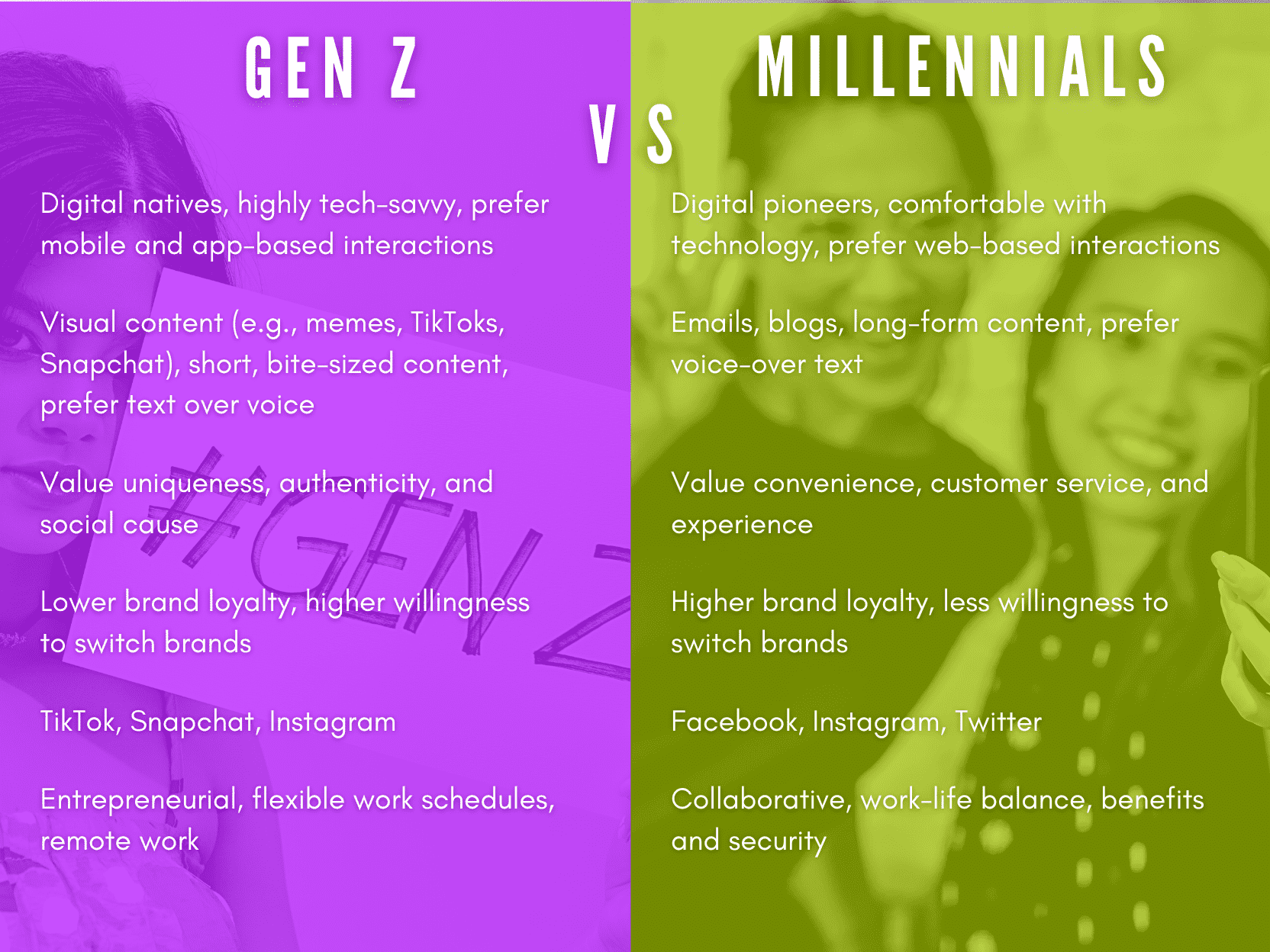"The key to engaging Gen Z and Millennials lies in authenticity, creativity, and an unwavering commitment to social responsibility."
The old ways of doing things simply won't cut it anymore. You'll need to learn the language of the digital natives, unlock the secrets of their online behavior, and craft strategies that resonate with their unique preferences. It's a daunting task, but fear not! This comprehensive guide is here to help you navigate the complex world of marketing to these generations while shedding light on how to tailor your enterprise SaaS marketing efforts to capture their hearts and wallets.
Without further ado, let's embark on this thrilling journey into the minds and screens of the modern buyer, exploring the essential tactics and techniques for connecting with Gen Z and Millennial consumers.

Part 1: Understanding the Modern Buyer
The Gen Z and Millennial Mindset
To craft a marketing strategy that effectively speaks to Gen Z and Millennials, you must first understand their unique traits, values, and preferences. These generations have grown up with technology as an integral part of their lives, and as a result, they possess a digital fluency that sets them apart from their predecessors.
Gen Z (born 1997-2012):
- Digital natives who have never known a world without the internet
- Value authenticity, diversity, and social responsibility
- More likely to engage with brands that share their values and beliefs
Millennials (born 1981-1996):
- Came of age during the rise of the internet and social media
- Seek experiences, personal growth, and a sense of purpose
- Crave genuine connections and personalization in their interactions with brands
The Role of Technology
Just as a painter uses a palette of colors to create a masterpiece, Gen Z and Millennials employ a wide array of digital tools to shape their lives. They are constantly connected to the internet, using smartphones and social media platforms to communicate, consume content, and make purchasing decisions. To engage with these tech-savvy consumers, marketers must become fluent in the language of digital communication.
Part 2: Adapting Your SaaS Marketing Strategy
The Power of Social Media
Social media has become the town square of the digital age, where Gen Z and Millennials gather to socialize, share, and discover. To connect with these consumers, you must establish a strong and consistent presence on the platforms they frequent.

Key Strategies:
- Platform Selection: Focus on the social media channels that resonate with your target audience. Popular choices include Instagram, TikTok, Twitter, and LinkedIn.
- Authenticity: Present your brand in an honest and transparent manner, showcasing your values and purpose.
- User-Generated Content (UGC): Encourage your audience to create and share content related to your brand, fostering a sense of community and belonging.
- Influencer Marketing: Partner with influencers who share your values and can help promote your brand to their followers.
Personalization and Customization
Like snowflakes, no two Gen Z or Millennial consumers are exactly alike. They crave personalized experiences that cater to their individual needs and preferences. By embracing personalization and customization in your marketing efforts, you can create a deeper connection with your audience.

Key Strategies:
- Segmentation: Divide your audience into smaller groups based on their behavior, preferences, or demographics. This allows you to tailor your messaging to each segment, increasing its relevance and effectiveness.
- Dynamic Content: Utilize marketing automation tools to deliver personalized content to each user based on their behavior, interests, or stage in the buyer's journey.
- Customization Options: Offer customers the ability to customize your product or service to suit their needs, demonstrating your commitment to meeting their unique requirements.
Harnessing the Power of Video
Video is the new lingua franca of the digital age, offering a dynamic and engaging medium through which to communicate with your audience. By incorporating video into your marketing strategy, you can capture the attention of Gen Z and Millennials and convey your message in a compelling manner.

Key Strategies:
- Video Formats: Experiment with various video formats, such as live streaming, short-form content (e.g., TikTok), and explainer videos, to identify what resonates best with your audience.
- Mobile Optimization: Ensure your videos are optimized for mobile viewing, as Gen Z and Millennials are more likely to consume content on their smartphones.
- Storytelling: Use video to tell engaging stories that showcase your brand's personality, values, and the benefits of your product or service. By doing so, you can forge an emotional connection with your audience, making your brand more memorable and appealing.
Part 3: Measurement and Optimization
Data-Driven Decision Making
Gen Z and Millennials live in a world where data is king. As a marketer, you must embrace this mindset by collecting and analyzing data to inform your marketing strategy, make data-driven decisions, and optimize your campaigns for maximum impact.

Key Strategies:
- Analytics Tools: Leverage analytics platforms like Google Analytics, Mixpanel, or Amplitude to track user behavior, engagement, and conversion metrics.
- A/B Testing: Conduct A/B testing to experiment with different messaging, visuals, or targeting options, and identify which approach resonates best with your audience.
- Feedback Loops: Establish feedback mechanisms (e.g., surveys, focus groups, or social listening) to gather insights from your customers, helping you understand their preferences and identify areas for improvement.
Adapting to Changing Trends
The digital landscape is ever-evolving, and to stay ahead of the curve, you must be prepared to adapt your marketing strategy in response to shifting trends and consumer preferences.
Key Strategies:
- Trend Monitoring: Keep an eye on emerging trends and popular culture by following industry news, social media conversations, and influencers in your niche.
- Agility: Be prepared to pivot your marketing strategy quickly when new opportunities or challenges arise. This may involve embracing new platforms, updating your messaging, or experimenting with different content formats.
- Continuous Learning: Foster a culture of learning within your marketing team, encouraging them to stay up-to-date with the latest tools, techniques, and best practices in the industry.
Embracing the Challenge
Marketing to Gen Z and Millennials may seem like a daunting task, but it is also an opportunity to innovate, grow, and connect with a new generation of consumers who are passionate, purpose-driven, and tech-savvy. By understanding their unique mindset, embracing digital communication channels, and constantly adapting to the ever-changing landscape, you can create a marketing strategy that resonates with the modern buyer and drives success for your enterprise SaaS business.
FAQ
1. How do Gen Z and Millennials differ from previous generations in terms of their marketing preferences?
Answer: Gen Z and Millennials have grown up with technology, making them more digitally fluent than previous generations. They prefer engaging with brands through social media, messaging apps, and video content, rather than traditional advertising methods. They also value authenticity, personalization, and social responsibility in marketing, seeking genuine connections with brands that align with their values and beliefs.
2. Why is social media marketing so important when targeting Gen Z and Millennials?
Answer: Social media is the primary communication channel for these younger generations, as they spend a significant amount of time on platforms such as Instagram, TikTok, Twitter, and LinkedIn. By establishing a strong presence on these platforms, you can engage with your target audience where they spend their time, build brand awareness, foster community, and encourage user-generated content.
3. What are some examples of personalization strategies that resonate with Gen Z and Millennials?
Answer: Examples of personalization strategies include:
- Segmenting your audience based on their behavior, preferences, or demographics to deliver tailored messaging
- Using marketing automation tools to deliver personalized content, offers, or recommendations based on each user's interests or behavior
- Offering customization options for your product or service, allowing customers to tailor it to their unique needs
4. How can video marketing be used to engage Gen Z and Millennials?
Answer: Video marketing is an effective way to engage younger audiences because it offers a dynamic, visual, and easily digestible format that appeals to their short attention spans. By incorporating various video formats (e.g., live streaming, short-form content, explainer videos) and using storytelling techniques, you can capture their attention, convey your message, and create an emotional connection with your audience.
5. How can data-driven decision-making improve my SaaS marketing strategy for Gen Z and Millennials?
Answer: Data-driven decision-making allows you to make informed decisions based on real insights from your target audience. By using analytics tools to track user behavior, engagement, and conversion metrics, you can identify patterns, trends, and areas for improvement. This information can then be used to optimize your marketing campaigns, ensuring they resonate with your audience and deliver the desired results.
6. Why is it important to stay agile and adapt to changing trends when marketing to Gen Z and Millennials?
Answer: The digital landscape is constantly evolving, and to stay relevant and effective, you must be prepared to adapt your marketing strategy in response to shifting trends and consumer preferences. By staying informed about new platforms, tools, and best practices, you can pivot your marketing efforts quickly and capitalize on emerging opportunities.
7. What are some ways to measure the success of my SaaS marketing efforts for Gen Z and Millennials?
Answer: Key performance indicators (KPIs) can help you gauge the effectiveness of your marketing efforts. Some important KPIs to track include:
- Awareness (e.g., impressions, reach, brand mentions)
- Engagement (e.g., likes, comments, shares, click-through rates)
- Conversion (e.g., sign-ups, free trials, sales, conversion rates)
- Retention (e.g., churn rate, customer lifetime value)
- Customer Feedback (e.g., net promoter score, customer satisfaction)
8. How can influencer marketing help reach Gen Z and Millennials?
Answer: Influencer marketing can be an effective way to reach younger audiences because it leverages the trust and credibility established by influencers with their followers. By partnering with influencers who share your values and resonate with your target audience, you can tap into their established communities and amplify your brand message.
9. How can I create content that resonates with Gen Z and Millennials?
Answer: To create content that resonates with Gen Z and Millennials, you should:
- Focus on authenticity: Be genuine and transparent in your messaging, showcasing your brand's values, mission, and personality.
- Prioritize storytelling: Use engaging narratives to convey your message, highlight customer success stories, or demonstrate the benefits of your product.
- Utilize visuals: Incorporate eye-catching visuals, such as images, infographics, or video content, to capture their attention and make your content more shareable.
- Emphasize social responsibility: Showcase your brand's commitment to sustainability, diversity, and social causes that resonate with your audience.
- Create platform-specific content: Tailor your content to the unique characteristics and user preferences of each social media platform.
10. How can I build a community around my SaaS brand with Gen Z and Millennials?
Answer: Building a community around your SaaS brand involves fostering a sense of belonging, engagement, and loyalty among your audience. Some strategies for achieving this include:
- Encouraging user-generated content: Prompt your customers to share their experiences, stories, or testimonials related to your product, and then feature this content on your social media channels or website.
- Hosting events or webinars: Organize virtual or in-person events where your audience can learn, network, and engage with your brand and each other.
- Creating online forums or communities: Provide platforms where your audience can ask questions, share ideas, and connect with other users who share their interests and challenges.
- Responding to comments and messages: Engage with your audience by actively responding to their comments, answering their questions, and addressing their concerns.
- Collaborating with influencers or industry experts: Partner with well-respected individuals in your niche to co-create content or host events, leveraging their credibility and expertise to engage your audience.






